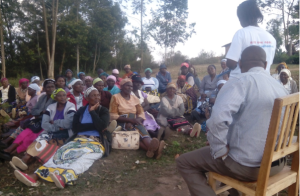Encouraging initial results during roll out of new program
NHIF's Health Insurance Subsidy Program in Kenya
- Nov 24, 2014
NHIF's Health Insurance Subsidy Program in Kenya
The Health Insurance Subsidy Program (HISP) is currently being launched in Kenya, an initiative of the National Hospital Insurance Fund (NHIF). The pilot project aims to extend health insurance coverage to beneficiaries who belong to the lowest quintile, those classified as absolutely poor and vulnerable, working in the informal sector in Kenya. The premium is fully subsidized by the Kenyan Government, and the NHIF is supported by the African Health Markets for Equity (AHME) consortium funded by the Bill & Melinda Gates Foundation and the UK’s Department for International Development (DFID). The enrolment is well under way in 14 counties showing that out of 6,237 households targeted, 4,663 enrolled (26,744 beneficiaries). This amounts to an inspiring enrolment rate of 75%.
In close collaboration with the AHME consortium partners, namely Population Services Kenya, Marie Stopes Kenya and International Finance Cooperation (IFC), PharmAccess has been supporting NHIF in designing, implementing and monitoring their marketing strategy, adapted to the needs of the target audience. This marketing component is part of the demand-side financing work stream that aims to increase utilization of services by the poor at quality private healthcare providers. The AHME consortium complements these activities by supply-side interventions such as improving quality of services at health facilities.
The roll out of HISP is done on a county by county basis, and will focus on awareness raising, training of direct stakeholders such as local leaders and NHIF branches, and enrolment of beneficiaries. In this first phase NHIF is aiming to enrol approximately 21,260 households (127,560 beneficiaries). In the second phase, the AHME partners will support the NHIF in stimulating beneficiaries to utilize the health insurance coverage. This will be done by community health workers that live in the same catchment areas as the main target audience.

The vast majority of Kenyans are not covered by any type of formal health insurance. Putting it in numbers: approximately 7.77 million (or 20% of the population) Kenyans are covered by insurance, of which the NHIF is responsible for covering 25%. This 25% represents the largest risk pool. NHIF is the sole public health insurer in Kenya, and under the commitment of the current Jubilee administration has the mandate to extend insurance coverage to all Kenyans. Over the past few years an uptake in this amount has already been seen, which can be credited to NHIF’s inclusion of the informal sector. The informal sector is currently responsible for employing 90% of working Kenyans, and this number is expected to continue growing since of the new jobs created 90% are again in the informal sector.